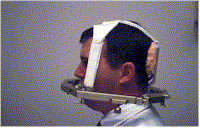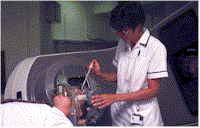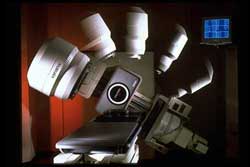|
|
||||||||||||||
|
A Guide to Stereotactic Radiotherapy |
||||||||||||||
Note: There are two forms of stereotactic radiotherapy. There is stereotactic surgery and stereotactic radiotherapy. For information on steresotactic radiosurgery, please see stereotactic radiosurgery. Stereotactic
Radiotherapy (fractioned) - What does it mean? It
is very precise delivery of radiation to a small area of the brain with sparing
of the surrounding normal brain. Fractionation means that the treatment course
is divided into multiple smaller doses or fractions given daily (Monday ~
Friday) over several weeks. This minimizes the effect of the radiation on the
normal brain and reduces the risk of late side effects. The
head frame serves three main purposes: 1.
It
enables accurate reproducibility of the treatment position for each planning and
treatment session. 2.
It
prevents movement of your head during the treatment 3.
It
removes the need for ink marks on your head or face. Prior to the treatment starting there are usually three planning visits needed. This leaflet aims to give a brief description of the planning and treatment process.
First visit – Making Your Frame At this appointment the frame attachments will be made
specifically for you. The frame is fitted and held securely on your head in two
ways: ¨
Mouth
bite ~ a denture plate that fits onto your upper teeth. ¨
Back
plate ~ a moulded support of the back of your head. Making the
mouth bite: Making the back plate: The
frame is then secured into place by straps across your head.
Second visit – Scanning and Planning
Third visit - Verification The
purpose of this visit is to check that your treatment plan is correct. This
process is called verification and is carried out on a x-ray machine called a
simulator. A set of x-rays will be taken of you positioned in the head frame.
This appointment normally lasts about an hour. Treatment The
treatment is given in one of the radiotherapy treatment rooms. At each treatment
the head frame will be fitted and measurements taken to ensure that it has been
located correctly. You will be positioned for treatment using the room lasers
and lights. Whilst
the machine is switched on the radiographers will leave the room but will be
watching you on closed circuit TV. They can stop the treatment at any time. You
will not feel anything during treatment but may be aware of a buzzing sound. The
treatment is divided into several fields with the treatment machine positioned
slightly differently for each. Each treatment field takes about one minute and
the radiographers will come into the treatment room between fields. The whole
treatment takes about 20 minutes to deliver. Each week throughout
the course of your treatment you will have an opportunity to see either the
doctor or a specialist radiographer to discuss any queries or problems that
arise. The radiotherapy will not make you ill and you will be well enough
to travel. Many patients carry on their normal daily activities before and after
the daily treatment session. Driving You may or may not be allowed to drive yourself. This should be discussed with your doctor prior to treatment. MedicationIf you are currently taking steroids, the dose is often kept at the same level between leaving hospital after your operation and starting radiotherapy. This dose may be adjusted during your radiotherapy following discussion with the doctor. Side effectsAny side effects vary from person to person. The type and site of your tumour may also determine the side effects you may experience. The most common side effects are listed below: Hair loss: Unfortunately, you will lose your hair in the area being treated. This normally happens two to three weeks after the beginning of radiotherapy. We try to arrange treatment so that your hair will re-grow, but your treatment will never be compromised for the sake of keeping your hair. Hair can take a long time to re-grow following radiotherapy. A wig can be organised for you if required. During radiotherapy you can continue to wash your hair normally but using a mild baby shampoo. The hair should be gently towel dried and a hairdryer should not be used.
Skin:
The skin in the treatment area may gradually redden from the second week of
treatment onwards. It may become dry, itchy and sore especially around the ears
if they are in the treatment area. To minimise dryness and irritation aqueous
lotion may be used in the treatment area. During the summer months the area
should be protected from the sun to prevent sun damage. Any reaction will soon
clear up after treatment has finished. Tiredness:
This side effect varies
greatly from person to person. Generally it increases throughout the
radiotherapy and may last for a few weeks after completion of your treatment
(see information on coping with fatigue). Pituitary function: In
some patients the pituitary gland may receive a dose of radiotherapy, this may
affect the gland and its hormone production. If it occurs, this happens a year
or more after radiotherapy, and is easily managed. If this side effect applies
to you, the team will explain it fully.
Further general information Your doctors and specialist nurses are in an ideal position to give you relevant information on your disease and treatment as they know your individual circumstances. Cancerbackup has a help line (0808 800 1234) and a prize winning video available in English, Italian, Urdu, Bengali, Gujarati & Hindi explaining Radiotherapy & Chemotherapy. Cancernet.co.uk has over 500 pages describing cancer, its management, practical tips and tool which patients, their carers and their doctors have found helpful during the cancer journey. |
||||||||||||||
 The
frame and the dental plate do not cover the mouth, nose or face and breathing is
not impeded. Once the frame has been made and is fitting well we do some
measurements to ensure that the frame can be relocated in the same position at
each visit. To do this we use a clear plastic helmet, called a depth helmet, and
a measuring probe. These measurements are taken with you lying down so that you
are in the same position as you will be for your treatment. Two or more sets of
measurements will be done on your first visit. Further sets of measurements will
be taken before any planning or treatment. To make the frame and take the
initial measurements takes approximately one hour.
The
frame and the dental plate do not cover the mouth, nose or face and breathing is
not impeded. Once the frame has been made and is fitting well we do some
measurements to ensure that the frame can be relocated in the same position at
each visit. To do this we use a clear plastic helmet, called a depth helmet, and
a measuring probe. These measurements are taken with you lying down so that you
are in the same position as you will be for your treatment. Two or more sets of
measurements will be done on your first visit. Further sets of measurements will
be taken before any planning or treatment. To make the frame and take the
initial measurements takes approximately one hour. At
this appointment a CT scan will be taken of you positioned in the head frame.
During the scan you may be given an injection of contrast: this is a dye that
helps to highlight the area needing treatment. The appointment usually lasts
about 30 minutes.
At
this appointment a CT scan will be taken of you positioned in the head frame.
During the scan you may be given an injection of contrast: this is a dye that
helps to highlight the area needing treatment. The appointment usually lasts
about 30 minutes. 




